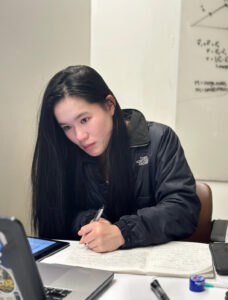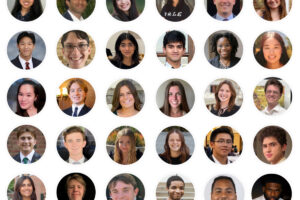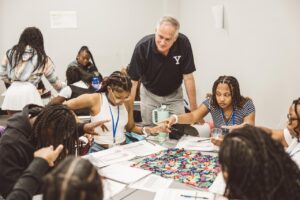
Beyond Physics: Building High-Achiever Identities in the Mississippi Delta
Global Teaching Project tutor Madison Butchko, a Michigan native, is a senior at Yale University, pursuing a B.S. in Physics and a B.A. in East Asian Studies. In the piece below, she reflects on her experiences working with AP Physics students in the Mississippi
Delta.
By: Madison Butchko
Photos by: Yale Daily News
In elementary school, I developed an unexpected passion for multiplication tables. Those daily timed tests became my arena where I consistently scored at the top, never missing a question. My teachers noticed, and before long, they recommended I skip ahead in math.
I didn’t realize it then, but that small ritual of repetition was teaching me something larger: how to believe I was capable. Being accelerated in mathematics branded me as “the smart kid,” an identity that would guide my decisions for years to come. This same process of identity formation now drives my work as an AP Physics teaching assistant with the Global Teaching Project in the Mississippi Delta. There, students’ potential often remains untapped—not because they lack ability, but because they’ve never been given the opportunity to see themselves as high achievers.
That early mathematical success created a powerful feedback loop. Each correct answer reinforced my confidence, each advancement confirmed my capabilities. I began making choices through the lens of “What would a smart person do?”. This wasn’t about arrogance but about having an internal compass that pointed toward academic challenge rather than away from it.
When junior year arrived and it was time to apply to college, I found myself unsure of where to begin. Coming from a public high school in Detroit, I had limited exposure to elite educational pathways. No one in my immediate circle talked about Ivy
League schools. Despite my academic success, I wasn’t confident about applying to top colleges. The identity I had formed as a “smart kid” didn’t eliminate doubt, but it gave me permission to try. I questioned whether I truly belonged in those spaces, yet that internal belief nudged me to look beyond what I knew. Even through the hesitation, it pushed me to explore options I might never have considered. That willingness to try, even without certainty, ultimately opened doors I hadn’t known existed.
My own experience with identity and access continues to shape the way I think about teaching and educational equity. During a recent conversation with Mr. Dolan, CEO of the Global Teaching Project, we discussed the profound educational inequities in the Mississippi Delta. These challenges go beyond resources and staffing. They’re rooted in identity and expectation. Many students have never had the opportunity to take advanced coursework, and without classes like AP Physics, they miss more than academic content. They miss the chance to see themselves as scholars. When students aren’t offered rigorous courses or don’t see themselves as candidates for them, they begin to believe those paths aren’t meant for them. Over time, this belief reinforces the idea that such opportunities aren’t necessary. Breaking this cycle requires intervention at both the practical and psychological levels.
That’s why the Global Teaching Project’s work is critical. By bringing AP Physics to schools where it previously didn’t exist, GTP is sending a powerful message to students that they deserve and can handle advanced study. The program’s impact is evident in the numbers: GTP now offers nearly half of AP Physics classes in Mississippi public schools, and GTP provides the only AP Physics classes taught in the state’s 25 highest poverty school districts.
But statistics only tell part of the story.
AP Physics works as an identity-builder precisely because it is difficult.

When students who never imagined themselves in such a class successfully solve complex equations or grasp counterintuitive concepts, their perception of their own capabilities expands dramatically. Each solved problem becomes evidence that they belong in advanced academic spaces.
My role as a teaching assistant extends far beyond explaining Newton’s laws or conservation of energy. The real work happens in the moments when a student who initially claimed “I’m not good at science” successfully predicts the trajectory of a projectile or calculates the work done by friction. I’ve witnessed students transform from hesitant participants to confident problem-solvers within weeks. One young woman entered our program convinced she wasn’t “math-minded.” After methodically working through increasingly difficult problems, she now confidently tackles new challenges with remarkable persistence. I tell my students: “If you can master AP Physics, you can do anything.” The analytical thinking, problem-solving skills, and intellectual stamina required for physics translate to every academic discipline and professional pursuit.
Furthermore, students who identify as high achievers make different choices about their futures. They consider colleges they previously wouldn’t have thought accessible. They pursue majors in fields where they’re traditionally underrepresented. One student recently told me he now plans to study engineering, a path he never considered before our program. “I figured out I’m actually good at understanding how things work,” he explained.
Just as my early academic successes reshaped what I believed I could achieve, I see that same shift taking place in my students. Long after Newton’s laws or kinematic equations are forgotten, what stays with them is the experience of having worked through something difficult and succeeded. That experience becomes part of who they are. As students begin to see themselves differently, communities begin to change. Economic opportunities grow. Expectations rise. The belief gap narrows. Teaching physics, at its core, is about helping students build a new sense of what they’re capable of. And once they begin to trust in that, their futures start to expand in ways they never imagined.



